
The .50 Action Express (AE) (12.7×33mmRB) is a large-caliber handgun cartridge, best known for its usage in the Desert Eagle. Developed in 1988 by American Evan Whildin of Action Arms, the .50 AE is one of the most powerful pistol cartridges in production.

The 10mm Auto is a powerful and versatile semi-automatic pistol cartridge introduced in 1983. Its design was adopted and later produced by ammunition manufacturer FFV Norma AB of Åmotfors, Sweden.

The .44 Remington Magnum, also known as .44 Magnum or 10.9x33mmR, is a rimmed, large-bore cartridge originally designed for revolvers and quickly adopted for carbines and rifles. Despite the ".44" designation, guns chambered for the .44 Magnum round, its parent case, the .44 Special, and its parent case, the .44 Russian all use 0.429 in (10.9 mm) diameter bullets. The .44 Magnum is based on the .44 Special case but lengthened and loaded to higher pressures for greater velocity and energy.
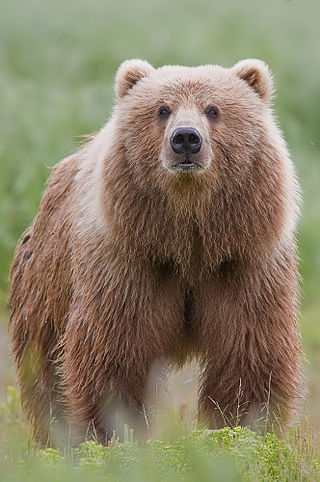
The Kodiak bear, also known as the Kodiak brown bear, sometimes the Alaskan brown bear, inhabits the islands of the Kodiak Archipelago in southwest Alaska. It is one of the largest recognized subspecies or population of the brown bear, and one of the two largest bears alive today, the other being the polar bear. They are also considered by some to be a population of grizzly bears.

The .308 Winchester is a smokeless powder rimless bottlenecked rifle cartridge widely used for hunting, target shooting, police, military, and personal protection applications globally. It is similar, but not identical, to the 7.62×51mm NATO cartridge.
The .480 Ruger (12.1×33mmR) is a large, high-power revolver cartridge, introduced in 2003 by Ruger and Hornady. It was the first new cartridge introduced by Ruger, and when introduced, was the largest-diameter production revolver cartridge, at .475 in (12.1 mm).

The 9.3×62mm is a rimless, bottlenecked rifle cartridge designed in 1905 by German gunmaker Otto Bock. It is suitable for hunting medium to large game animals in Africa, Asia, Europe, and North America. At a typical velocity of 720 m/s (2362 ft/s), its 286 gr standard load balances recoil and power for effective use at 250m to 300m. The C.I.P. Maximum Average Pressure (MAP) for the 9.3×62mm is 390.00 MPa (56,565 psi).
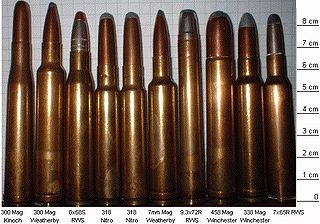
The .458 Winchester Magnum is a belted, straight-taper cased, Big Five game rifle cartridge. It was introduced commercially in 1956 by Winchester and first chambered in the Winchester Model 70 African rifle. It was designed to compete against the .450 Nitro Express and the .470 Nitro Express cartridges used in big bore British double rifles. The .458 Winchester Magnum remains one of the most popular large game cartridges, and most major ammunition manufacturers offer a selection of .458 ammunition.

The .338 Winchester Magnum is a .338 in (8.6 mm) caliber, belted, rimless, bottlenecked cartridge introduced in 1958 by Winchester Repeating Arms. It is based on the blown-out, shortened .375 H&H Magnum. The .338 in (8.6 mm) is the caliber at which medium-bore cartridges are considered to begin. The .338 Winchester Magnum is the first choice among professional brown bear guides in Alaska to back up clients where a powerful stopping caliber is required on charging bears. It is also the most popular medium-bore cartridge in North America and has the most widely available choice in rifles among medium bore rifles. The action length is the same as a .30-06, and most major rifle manufacturers in the United States chamber rifles for the cartridge including the semi-automatic Browning BAR Mk II Safari, making it a very powerful combination against charging dangerous game. The cartridge was intended for larger North American big-game species and has found use as for the hunting of thin-skinned African plains-game species.

The Super Redhawk is a line of double-action magnum revolvers made by Sturm, Ruger beginning in 1987, when Ruger started making weapons using larger, more powerful cartridges such as .44 Magnum, .454 Casull, and .480 Ruger.
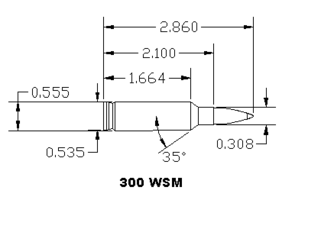
300 Winchester Short Magnum is a .30 caliber rebated rim bottlenecked centerfire short magnum cartridge that was introduced in 2001 by Winchester.
The wildlife of Alaska is both diverse and abundant. The Alaskan Peninsula provides an important habitat for fish, mammals, reptiles, and birds. At the top of the food chain are the bears. Alaska contains about 70% of the total North American brown bear population and the majority of the grizzly bears, as well as black bears and Kodiak bears. In winter, polar bears can be found in the Kuskokwim Delta, St. Matthew Island, and at the southernmost portion of St. Lawrence Island. Other major mammals include moose and caribou, bison, wolves and wolverines, foxes, otters and beavers. Fish species are extensive, including: salmon, graylings, char, rainbow and lake trout, northern pike, halibut, pollock, and burbot. The bird population consists of hundreds of species, including: bald eagles, owls, falcons, ravens, ducks, geese, swans, and the passerines. Sea lions, seals, sea otters, and migratory whales are often found close to shore and in offshore waters. The Alaskan waters are home to two species of turtles, the leatherback sea turtle and the green sea turtle. Alaska has two species of frogs, the Columbia spotted frog and wood frog, plus two introduced species, the Pacific tree frog and the red-legged frog. The only species of toad in Alaska is the western toad. There are over 3,000 recorded species of marine macroinvertebrates inhabiting the marine waters, the most common being the various species of shrimp, crab, lobster, and sponge.

Bear spray is a specific aerosol spray bear deterrent, whose active ingredients are highly irritant capsaicin and related capsaicinoids, that is used to deter aggressive or charging bears.

The .416 Remington Magnum is a .416 caliber (10.57 mm) cartridge of belted bottlenecked design. The cartridge was intended as a dangerous game hunting cartridge and released to the public in 1989. The cartridge uses the case of the 8 mm Remington Magnum as a parent cartridge. When the cartridge was released in 1988, author Frank C. Barnes considered the .416 Remington Magnum to be the "most outstanding factory cartridge introduced in decades".
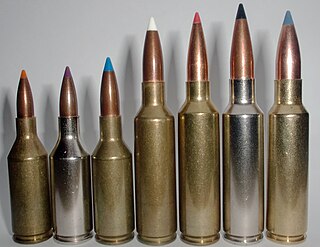
The .325 Winchester Short Magnum, commonly known as the 325 WSM, is an 8mm caliber rebated rim bottlenecked centerfire short magnum medium bore cartridge. The cartridge was introduced by Winchester Ammunition in 2005.

A bear attack is an attack by a bear on another animal, although it usually refers to a bear attacking a human or domestic pet. Bear attacks are of particular concern for those who are in bear habitats. They can be fatal and often hikers, hunters, fishers, and others in bear country take precautions against bear attacks.
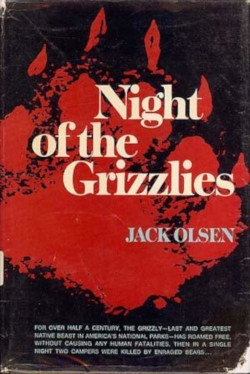
Night of the Grizzlies (1969) is a book by Jack Olsen which details events surrounding the night of August 13, 1967, when two young women were separately attacked and killed in Glacier National Park, Montana, by grizzly bears. Both women, Julie Helgeson, 19, of Albert Lea, Minnesota, and Michele Koons, 19, of San Diego, California, died of their injuries.
The .500 S&W Magnum or 12.7×41mmSR is a .50 caliber semi-rimmed revolver cartridge developed by Cor-Bon in partnership with the Smith & Wesson "X-Gun" engineering team for use in the Smith & Wesson Model 500 X-frame revolver and introduced in February 2003 at the SHOT Show. From its inception, it was intended to be the most powerful handgun cartridge to date, with the capacity to harvest all North American game species. While more powerful handgun cartridges, such as the .500 Bushwhacker, have emerged since, they are only available in custom firearms, and the .500 S&W remains the most powerful production handgun cartridge.
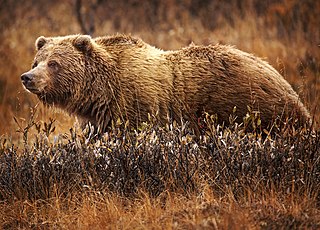
The grizzly bear, also known as the North American brown bear or simply grizzly, is a population or subspecies of the brown bear inhabiting North America.
The .460 Rowland / 11.43×24mm is a rimless, straight walled handgun cartridge designed in 1997 by Johnny Rowland and developed in conjunction with Clark Custom Guns as a derivative of the .45 ACP with the goal of producing a cartridge which can achieve true .44 Magnum ballistic performance and be fired from a semi-automatic platform. Despite its name, the Rowland is a true .45 caliber cartridge, like its parent.






















